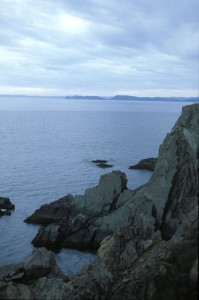Neoproterozoic to Cambrian stratigraphy and depositional history of Newfoundland.
Photo: Shoreline outcrop of the Neoproterozoic-Lower Cambrian Chapel Island Formation outside of the town of Grand Bank, Burin Peninsula, Newfoundland. The type section of the Precambrian-Cambrian boundary is placed within these rocks.My PhD dissertation was a study of the Chapel Island Formation, a shallow marine succession of siliciclastic and carbonate strata that straddles the Precambrian–Cambrian boundary. In collaboration with Ed Landing (N.Y. State Museum) and Guy Narbonne (Queen’s University) a main measured section of my thesis (Fortune Head) became the type section of this boundary. I have worked on numerous aspects of these rocks including details of the sedimentary structures and lithofacies, biogenic features, and biostratigraphy. A later study looked at a thin, Neoproterozoic cap carbonate bed at the top the glaciogenic Gaskiers Formation. Finally, in collaboration with Sam Bowring (MIT) and others, we have dated a number of ash beds found stratigraphically below, within, and above the Gaskiers.
Refereed Publications/Guidebooks:
Darroch, S.A.F., Sperling, E.A., Boag, T., Racicot, R.A., Mason, S., Morgan, A.S., Tweedt, S., Myrow, P.M., Johnston, D.T., Erwin, D.H., and Laflamme, M., 2015, Low diversity of terminal Ediacaran assemblages supports a ‘biotic replacement’ model for the end of the Ediacara biota: Proceedings of the Royal Society B: Biological Sciences, 20151003.
Buatois, L.A., Narbonne, G.M., Mangano, M.G., Carmona, N.B., and Myrow, P.M., 2014, Ediacaran matground ecology persisted into the earliest Cambrian: Nature Communications, DOI: 10.1038/ncomms4544.
McKenzie, N.R., Hughes, N., Gill, B.C., and Myrow, P.M., 2014, Plate tectonic influences on Neoproterozoic–Early Paleozoic climate and animal evolution: Geology, v. 42, p. 127-130.
Myrow, P.M., and Narbonne, G., 2012, The dawn of the Paleozoic on the Burin Peninsula: Field Trip Guidebook A2, Geological Association of Canada National Meeting Field Trip, 42 p.
Droser, M.L., Jensen, S., Gehling, J.G., Myrow, P.M., and Narbonne, G.M., 2002. Lowermost Cambrian ichnofabrics from the Chapel Island Formation, Newfoundland: implications for Cambrian substrates: Palaios, v. 17, p. 3-15.
Gehling, J.G., Jensen, S., Droser, M.L., Myrow, P.M., and Narbonne, G.M., 2001, Burrowing below the basal Cambrian GSSP, Fortune Head, Newfoundland: Geological Magazine, v. 138, p. 213-218.
Myrow, P.M., and Kaufman, A.J., 1999, A cap carbonate above Varanger age glacials in Newfoundland: Journal of Sedimentary Research, v. 69, p. 784-793.
Myrow, P.M., 1995, Neoproterozoic rocks of the Newfoundland Avalon Zone: in Knoll, A.H. and Walter, M., eds., Neoproterozoic Stratigraphy and Earth History: Special Issue of Precambrian Research, v. 73, p. 123-136.
Myrow, P.M., 1994, Pot and gutter casts from the Chapel Island Formation, southeast Newfoundland — reply: Journal of Sedimentary Petrology, v. A64, p. 706-709.
Myrow, P.M., and Hiscott, R.N., 1993, Depositional history and sequence stratigraphy of the potential boundary stratotype section for the Precambrian–Cambrian boundary, Chapel Island Formation, southeast Newfoundland, in Geldzetser, H. and Nowlan, G., eds., Event Markers in Earth History: Special Issue of Palaeogeography, Palaeoclimatology, Palaeoecology, v. 104, p. 13-35.
Myrow, P.M., 1992, Bypass-zone tempestite facies model and proximality trends for an ancient muddy shoreline and shelf: Journal of Sedimentary Petrology, v. 62, p. 99-115.
Myrow, P.M., 1992, Pot and gutter casts from the Chapel Island Formation, southeast Newfoundland: Journal of Sedimentary Petrology, v. 62, no. 4, p. 992-1007.
Myrow, P.M., and Landing, E., 1992, Mixed siliciclastic–carbonate deposition in a lower Cambrian oxygen-stratified basin, Chapel Island Formation southeastern Newfoundland: Journal of Sedimentary Petrology, v. 62, p. 455-473.
Strauss, H., Bengtson, S., Myrow, P.M., Vidal, G., 1992, Stable isotope geochemistry and palynology of the late Precambrian to early Cambrian sequence in Newfoundland: Canadian Journal of Earth Sciences, v. 29, p. 1662-1673.
Myrow, P.M., and Hiscott, R. N., 1991, Shallow-water gravity-flow deposits, Chapel Island Formation, southeast Newfoundland, Canada: Sedimentology, v. 38, p. 935-959.
Narbonne, G.N., Myrow, P.M., Landing, E. and Anderson, M.M., 1991, A chondrophorine (medusoid hydrozoan) from the basal Cambrian (Placential) of Newfoundland: Journal of Paleontology, v. 65, p. 186-191.
Landing, E., Myrow, P.M., Benus, A., and Narbonne, G.M., 1989, The Placentian Series: appearance of the oldest skeletalized faunas in Southeastern Newfoundland: Journal of Paleontology, v. 63, p. 739-769. [Best Paper Award].
Landing, E., Narbonne, G., and Myrow, P.M., (eds.), 1988, Trace fossils, small shelly fossils, and the Precambrian–Cambrian boundary: New York State Museum Bulletin 463, The University of the State of New York, The State Education Department, Albany, N.Y., 98 p.
Landing, E., Narbonne, G.M., Myrow, P.M., Benus, A., and Anderson, M M., 1988, Faunas and depositional environments of the upper Precambrian through Lower Cambrian, Southeastern Newfoundland: New York State Museum Bulletin 463, The University of the State of New York, The State Education Department, Albany, N.Y., p. 18-52.
Myrow, P.M., Narbonne, G.M., and Hiscott, R.N., 1988, Storm-shelf and tidal deposits of the Chapel Island and Random formations, Burin Peninsula: facies and trace fossils: Geological Association of Canada Annual Meeting, Field Trip Guidebook B6, 108 p.
Narbonne, G.M. and Myrow, P.M., 1988, Trace fossil biostratigraphy in the Precambrian–Cambrian boundary interval, in Landing, E., Narbonne, G., and Myrow, P., eds., Trace Fossils, Small Shelly Fossils and the Precambrian–Cambrian Boundary: New York State Museum Bulletin 463, The University of the State of New York, State Education Department, Albany, N.Y., p. 72-76.
Narbonne, G., Myrow, P.M., Landing, E. and Anderson, M.M., 1987, A candidate stratotype for the Precambrian—Cambrian southeastern Newfoundland: Canadian Journal of Earth Sciences, v. 24, p. 1277-1293.

